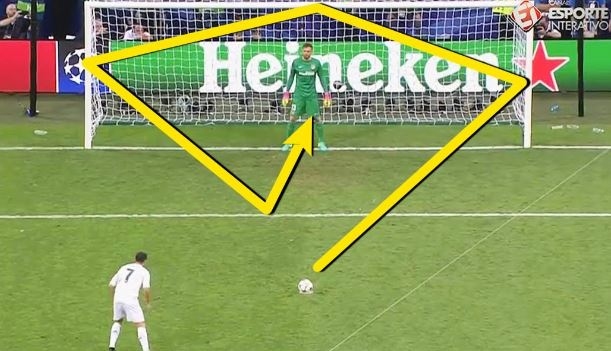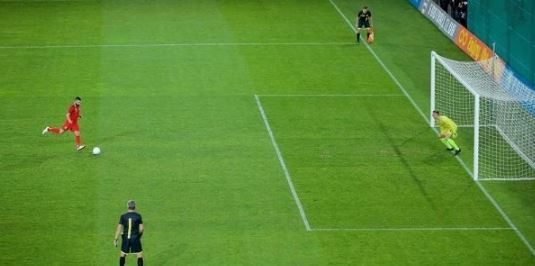In the world of soccer, there are many concepts and terminologies that may sound quite unfamiliar. If you have recently gotten into this sport, you might have occasionally heard about taking penalty kicks. If you're still unclear about how to properly execute an 11m penalty kick, as well as the latest FIFA regulations regarding it, this article is for you. Here, not only will
olbg.com Casino address these questions, but we will also offer strategies for players taking the penalty kicks and tips on how to successfully save them if you're playing as a goalkeeper.

The Concept of Penalty Kicks in Soccer
How far is a penalty kick is a common question among those new to watching soccer. It is taken from a spot 11 meters away by a player from the attacking team. This player will face the goalkeeper directly in a one-on-one situation. This is considered the most severe penalty for infractions in soccer. The success rate of scoring a goal from a penalty kick is over 98%, significantly increasing the attacking side's chance to score a decisive goal.
What is a penalty kick?
When a player commits a serious foul against an opponent within the 16.5m penalty area, or accidentally handles the ball, their team will be awarded a direct penalty kick. At this moment, the attacking team gains an advantage from the situation. The psychological pressure now heavily weighs on the opposing team's goalkeeper.
This is a scenario that any player in the defensive line, or the defensive area, should strive to avoid. In many instances, the attacking team may perform a feint or intentionally deceive the referee to win this unique penalty opportunity. Therefore, if you are playing in a defensive role, it is crucial to be as cautious as possible.
Is a penalty the same as a Penalty Kick?
Many people wonder whether a penalty kick is the same as a penalty. We would like to clarify that they carry different meanings. Essentially, the two methods of kicking are similar. That is, a one-on-one face-off between the player and the goalkeeper from the 11m spot. However, in soccer terminology, we need to understand it as follows:
Penalty Kick: This occurs when the defensive team commits a foul against the attacking team. Common fouls include kicking, pulling, or handball within the 16.5m area near the goal. In such cases, the referee will blow the whistle, point to the spot of the infraction, and signal for the penalty. Penalty kicks are only taken during the 90 minutes of regular play and any added time.
Penalty Shootout: Also known as taking Pens, is a method used to decide the winner by each team taking turns to shoot 5 penalties. Penalty shootouts are applied in some major soccer matches that require an immediate win-loss result after the game ends in a draw post-90 minutes. No rebound is allowed if a penalty is missed during a shootout. For example, in the World Cup 2022 final, the match between Argentina and France ended 3-3, leading to a penalty shootout to determine the winner. The result was 4-2 in favor of Argentina. Lionel Messi and his teammates officially claimed the championship title along with the prestigious Golden Ball award.
Situations leading to penalty kicks
Thus, penalty kicks are something that players should avoid to prevent falling behind by a goal. Most fouls leading to a penalty are determined by the main referee, particularly for serious offenses occurring close to the goal. Read through the following offenses to learn more.

Kicking or stamping on an opposing player.
Insulting, demeaning, or spitting at anyone on the field.
Sliding tackles on an opponent or intentionally pulling on the jersey of a player from the opposing team.
Jumping at, hitting, or intentionally injuring an opposing player.
Committing handball within one's own 16.5m penalty area (except for the goalkeeper).
Penalty kick rules quoted from FIFA regulations
The current rules are very clearly documented on how to execute a penalty kick. According to the information we have updated from the FIFA Football Association, the specific rules are as follows:
The penalty kick will be placed exactly at the designated point, 11m away from the goal. Aside from the player designated for the penalty kick from the attacking team, all other players must stand outside the penalty area.
The position of the defending team's goalkeeper must be on the goal line, between the goalposts, facing the ball. The goalkeeper is not allowed to move before the ball has been kicked. If the goalkeeper moves before the player touches the ball, the penalty will be retaken from the beginning.
The penalty will be executed at the signal of the main referee's whistle. The player taking the penalty is not allowed to touch the ball a second time until it has touched another player.
A goal from a penalty kick will be recognized when the ball rolls over the goal line within the goal frame.
If the player misses the penalty, the game will restart with a goal kick from the opposing team's goalkeeper. The match will continue as normal.
Tactics for effectively executing penalty kicks
After understanding the rules for the 11m penalty kick, newcomers should also remember the following tactics. We have meticulously compiled and recorded these from experienced coaches around the world. There are two approaches: one for the penalty taker and one for the goalkeeper.
Strategies for goal scorers to net penalties
The chosen penalty taker is someone with stable performance and a strong mentality in front of the goal. When facing goalkeepers who are adept at
best winning prediction app download shots, the taker should have suitable strategies, such as using feints during the run-up to deceive the goalkeeper. Possessing the skills to shoot accurately, adjust the ball's trajectory correctly, and apply strong kicking force are essential factors for success. Confidence and a 1% stroke of luck are also key.
The rules for taking an 11m penalty do not prohibit coordination between two players. Thus, the direct penalty taker can execute a pass from the penalty spot, coordinating with another player for the finishing shot. This method requires quick reflexes but also carries a lot of risks and is not highly successful, which is why it has long been out of practice in competitive matches.
Goalkeeper tactics for successfully saving penalty kicks
Blocking can be considered a difficult task for goalkeepers. This is because the shot is taken from a close distance, and the strong force of the ball makes it hard to predict its direction and flight path. Therefore, two tactics commonly used by goalkeepers during penalty kicks are:
Studying the opponent's habits: In major matches, teams often
football odds analysis scoring abilities, including who the main penalty taker is and their preferred foot. This allows goalkeepers to have information and predict the intentions of the penalty taker. Ignore the deceptive movements they make. Instead, rely on experience and intuition at that moment to catch the ball.
Delaying slightly, feigning movements: Some goalkeepers tend to prolong the time to catch the ball to read the opponent. Then, they might fake a few jumps to distract the penalty taker's focus. However, this tactic should be applied cleverly to avoid being penalized by the referee.
Conclusion
Penalty kicks are one of the golden opportunities to score a goal. With a precise penalty shot, teams can turn the tide of the game. In today's football, there are many beautiful goals made by famous players. If readers are interested, remember to follow us daily. Our online casino and sports section is always pleased to bring readers the latest news updates. Read more: The Finest Free
hot football tips 1x2 Predictions for Today and Tomorrow